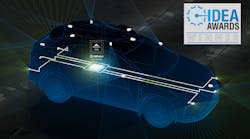Check out the other 2023 IDEA Award Nominees.
What you’ll learn:
- An introduction to Amberella’s 4D Imaging Radar System.
- Details regarding the system’s features and software.
Autonomous vehicles and robots rely on radar to detect its surrounding environment with the use of numerous front ends and MIMO antennas. But the numerous radars needed to do this means managing large amounts of data, which often causes issues. California-based chipmaker Ambarella wants to overcome these challenges and streamline the entire process with its new centrally processed 4D imaging radar system. It allows for both central processing of raw radar and deep, low-level fusion with other sensor inputs, including cameras, ultrasonics, and lidar.
Why make things centralized? Centralized processing offers improved environmental perception and safer path planning in AI-based advanced driver-assistance systems (ADAS) and L2+ to L5 autonomous-driving systems, including autonomous robots and drones. The new system features Ambarella’s Oculii radar technology running on its 5-nm CV3 AI Domain Control SoCs in addition to AI software algorithms that dynamically adapt radar waveforms to the surrounding environment.
By using fewer MIMO channels, it reduces the data bandwidth and reaches lower power consumption than other 4D imaging radars, said Ambarella. Its Oculii technology with a centralized 4D imaging radar offers a flexible and high-performance architecture that enables system integrators to future-proof their radar designs.
“There were ~100M radar units manufactured in 2021 for automotive ADAS,” explains Cédric Malaquin, Team Lead Analyst of RF activity at Yole Intelligence, part of Yole Group. “We expect this volume to grow 2.5-fold by 2027, given the more demanding regulations on safety and more advanced driving automation systems hitting the road. Indeed, from the current one to three radar sensors per car, OEMs will move to five radar sensors per car as a baseline.
“Besides, there is an exciting debate on the radar processing partitioning and many developments associated. One approach is centralized radar computing that will enable OEMs to offer significantly higher-performance imaging radar systems and new ADAS/AD features while simultaneously optimizing the cost of radar sensing.”
Oculii Algos Central to the CV3 Family
To achieve this centralized system, Ambarella optimized the Oculii algorithms for its CV3 AI domain controller SoC family in 5-nm geometries and added specific radar signal-processing acceleration. The CV3’s AI performance per watt offers the high computer and memory capacity required to achieve high radar density, range, and sensitivity. According to the company, a single CV3 simultaneously provides high-performance, real-time processing for perception, low-level sensor fusion, and path planning.
This isn’t to say 4D imaging radar technologies don’t come with their own challenges. Typically, datasets of 4D radar are too large to transport and process centrally. This is because they generate multiple terabits per second of data per module and consume more than 20 W of power per radar module. When this is multiplied across six or more radar modules needed to cover a vehicle, it can be too overwhelming for a central processor to handle.
Sensor Fusion
How will Ambarella address this? Its low-level signal sensor fusion enables the system to change the scanning characteristics of vehicle radars depending on the application, such as different settings for field-of-view and range when parking. This reduces the antenna array for each processor-less MMIC radar head while achieving high 0.5 degrees of joint azimuth and elevation angular resolution. The centralized architecture also uses less power at maximum duty cycle and reduces bandwidth for data transport by 84%.
Furthermore, it allows dynamic allocation of the CV3’s processing resources, based on real-time conditions. For instance, if you’re driving on the highway in the rain, the CV3 can focus on data coming from the front-facing radar sensors to further extend the vehicle’s detection range while providing faster reaction times. Other benefits of centralized architecture include easier over-the-air (OTA) software updates for further improvement and future proofing.
As we start to see more smart cars, especially autonomous vehicles, on the road, Ambarella’s centrally processed system seems attractive. However, so far, the company hasn’t revealed when it’ll hit the market or which manufacturers have expressed interest. Back in January, they showed off the technology at CES 2023, but have kept things under wraps since then.

